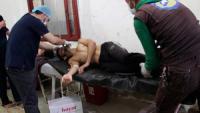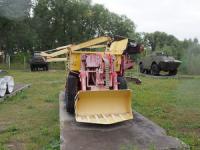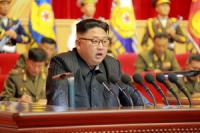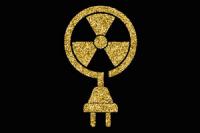-
At least 58 killed in Syrian army’s chemical attack in rebel-held Idlib province

At least fifty-eight people were killed in a chemical attack the Syrian military launched by against a rebel-held Syrian town in Idlib province Tuesday morning. Medics rushed scores of injured civilians to a hospital – but the Syrian air force then bombed the hospital, reducing it to rubble. This is the third reported chemical attack in Syria in just over a week. The previous two were reported in Hama province, in an area not far from Khan Sheikhoun, the site of Tuesday’s attack.
-
-
“Lab-on-a-glove” brings nerve-agent detection to a wearer's fingertips
Organophosphate nerve agents, including sarin and VX, are highly toxic and can prevent the nervous system from working properly. Organophosphate pesticides are far less potent but work in a similar way and can cause illness in people who are exposed to them, according to the U.S. Centers for Disease Control and Prevention. Detecting either type of these sets of compounds accurately and quickly could help improve both defense and food security measures.
-
-
Nextgen robots for nuclear clean-up

The cost of cleaning up the U.K.’s existing nuclear facilities has been estimated to be between £95 billion, and £219 billion over the next 120 years or so. The harsh conditions within these facilities means that human access is highly restricted and much of the work will need to be completed by robots. Present robotics technology is simply not capable of completing many of the tasks that will be required. A research a consortium to build the next generation of robots that are more durable and perceptive for use in nuclear sites.
-
-
Declassifying rescued nuclear test films
The United States conducted 210 atmospheric nuclear tests between 1945 and 1962, with multiple cameras capturing each event at around 2,400 frames per second. But in the decades since, around 10,000 of these films sat idle, scattered across the country in high-security vaults. Not only were they gathering dust, the film material itself was slowly decomposing, bringing the data they contained to the brink of being lost forever. For the past five years, physicists, film experts, archivists, and software developers have been on a mission to hunt down, scan, reanalyze, and declassify these decomposing films. The goals are to preserve the films’ content before it is lost forever, and provide better data to the post-testing-era scientists.
-
-
“Fishing out” radioactive elements from nuclear waste
Scientists have revealed how arsenic molecules might be used to “fish out” the most toxic elements from radioactive nuclear waste — a breakthrough that could make the decommissioning industry even safer and more effective. “Nuclear power could potentially produce far less carbon dioxide than fossil fuels, but the long-lived waste it produces is radioactive and needs to be handled appropriately,” one scientists said.
-
-
Detecting weapons-grade uranium from afar
It is hard enough to identify nuclear materials when you can directly scan a suspicious suitcase or shipping container. But if you cannot get close? A technique for detecting enriched uranium with lasers could help regulators sniff out illicit nuclear activities from as far as a couple of miles away.
-
-
Radiation threat detection system successfully tested in Washington, D.C.
DARPA’s SIGMA program — whose goal is to prevent attacks involving radiological “dirty bombs” and other nuclear threats — concluded its biggest and longest test deployment of vehicle-mounted radiation detectors in Washington, D.C., in February. For approximately seven months starting in July 2016, the fleet of D.C. Fire and Emergency Medical Services ambulances was outfitted with DARPA-developed nuclear and radiological detectors, providing the first city-scale, dynamic, real-time map of background radiation levels throughout the Capital as well as identifying any unusual spikes that could indicate a threat.
-
-
Preventing nuclear waste seepage
Nuclear waste is a reality, whether remnants of nuclear weapons or the byproducts of nuclear power plants. While we aren’t at risk of an attack from a giant radioactive lizard, nuclear waste can still pose threats to human health. The best way to safely store and contain nuclear waste is by mixing it into a cement grout and storing it in large concrete vaults. Researchers are testing the permeability of these grout mixtures and in turn, the ability for nuclear materials to eventually flow through the solidified grout and into the environment.
-
-
Large dose of VX killed Kim Jong-nam in 15-20 minutes

Kim Jong-nam, the half-brother of North Korea’s leader, was attacked with a large doze of VX which caused his death within 15-20 minutes after being poisoned by a nerve agent at Kuala Lumpur airport, the Malaysian health minister, S. Subramaniam, said on Sunday. Some experts have suggested that the two women who attacked him might have each smeared Kim’s face with two different non-lethal elements of VX, which became deadly when mixed on his face.
-
-
System automatically detects cracks in steel components of nuclear power plants
The United States operates 99 commercial nuclear power plants, which account for about 20 percent of total U.S. electricity generation. Aging can result in cracking, fatigue, embrittlement of metal components, wear, erosion, corrosion and oxidation. Researchers have developed a new automated system which detects cracks in the steel components of nuclear power plants and has been shown to be more accurate than other automated systems.
-
-
Kim Jong-nam killed by VX nerve agent: Malaysian police
Malaysian police have said the substance used in the killing of Kim Jong-nam was a VX nerve agent. North Korea, which is not a member of the Chemical Weapons Convention (CWC), is in possession of a large stockpiles of chemical weapons — between 2,500 and 5,000 metric tons, with Sarin and VX making up the bulk of the arsenal. Experts say that the public nature of the killing, and the assailants’ disregard for the safety of bystanders, is comparable to the assassination in London of former Russian intelligence officer Alexander Litvinenko. Litvinenko, who became a fierce critic of Vladimir Putin, was killed on Putin’s orders by two agents of the FSB in London in November 2006. The agents placed small quantities of radioactive poison, polonium-210, in his tea.
-
-
Finding new clues for nuclear waste cleanup
Technetium-99 is a byproduct of plutonium weapons production and is considered a major U.S. challenge for environmental cleanup. At the Hanford Site nuclear complex in Washington state, there are about 2,000 pounds of the element dispersed within approximately 56 million gallons of nuclear waste in 177 storage tanks. The U.S. Department of Energy is in the process of building a waste treatment plant at Hanford to immobilize hazardous nuclear waste in glass. But researchers have been stymied because not all the technetium-99 is incorporated into the glass and volatilized gas must be recycled back into the melter system.
-
-
Identifying the right sites for storing radioactive waste
In 2008, a Swiss government agency identified six regions in Switzerland, approved by the Federal Council, which could be used to store radioactive waste. An EPFL research project has developed a detailed profile of the sites selected to store radioactive waste from Swiss nuclear power plants. The project helped identify the two sites that meet both safety and feasibility requirements.
-
-
Device rapidly, accurately, inexpensively detects Zika virus at airports, other sites
About the size of a tablet, a portable device that could be used in a host of environments like a busy airport or even a remote location in South America, may hold the key to detecting the dreaded Zika virus accurately, rapidly and inexpensively using just a saliva sample. While scientists across the world are scrambling to find some sort of immunization, researchers are working to develop a diagnostic tool to reduce the impact of the outbreak until a vaccine is identified.
-
-
U.K. nuclear safety regulations place too low a value on human life

New research has shown that the benchmark used by the U.K. Office for Nuclear Regulation for judging how much should be spent on nuclear safety has no basis in evidence and places insufficient value on human life. The review suggests it may need to be ten times higher — between £16 million and £22 million per life saved.
-
More headlines
The long view
Keeping the Lights on with Nuclear Waste: Radiochemistry Transforms Nuclear Waste into Strategic Materials
How UNLV radiochemistry is pioneering the future of energy in the Southwest by salvaging strategic materials from nuclear dumps –and making it safe.
Model Predicts Long-Term Effects of Nuclear Waste on Underground Disposal Systems
The simulations matched results from an underground lab experiment in Switzerland, suggesting modeling could be used to validate the safety of nuclear disposal sites.
